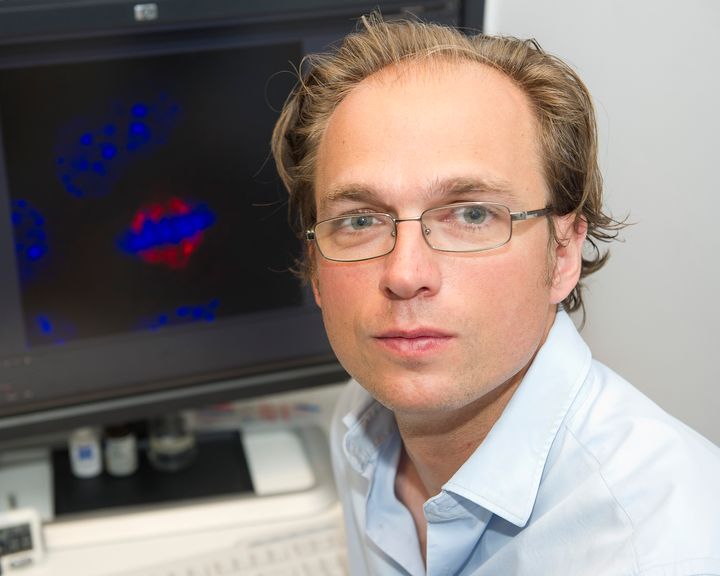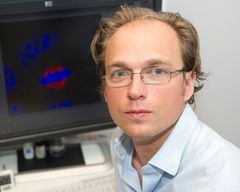Receptor dynamics provide new potential for pharmaceutical developments
[PRESS RELEASE 2017-08-09] The dynamics among certain so-called G protein-coupled receptors, of vital importance for the function of cells in the body, are different than previously believed. This has been reported by researchers from Karolinska Institutet in the journal Nature Communications. As these types of receptors are the target for many different medicines, the new finding opens the doors to completely new opportunities within pharmacology and pharmaceutical development.

G protein-coupled receptors belong to one of the largest protein families, with around 800 representatives in the human body that send numerous signals around the body. These receptors are found in the cell membrane and are activated by messenger molecules outside the cell, such as adrenaline, dopamine, histamine and endorphins. The receptors are not only important for cellular function by interpreting messages from outside the cell and subsequently activating signals inside the cell, they are also the target for a number of different and important medicines. Examples of such are betablockers, antihistamines, morphine and L-DOPA.
The discovery of G protein-coupled receptors resulted in a Nobel Prize in Chemistry in 2012. It has been known for some time now that the receptors can act either individually or in pairs, as so-called dimers. Their capacity to function in different constellations has been seen as a challenge, but also an opportunity for pharmacology and pharmaceutical development. To date, the hypothesis has been that G protein-coupled receptors function either as individual receptors or in pairs, and that this is stable.
An international team of researchers, led by a group from Karolinska Institutet, has now shown that a specific G protein-coupled receptor named Frizzled 6 (FZD6) can switch between acting in pairs and as an individual receptor, and that this switch is of vital importance for activation of the receptor. FZD6 is important for embryonic development and is significantly expressed in lung tissue. The new study demonstrates that the receptor acts in pairs when it is inactive, and that stimulation with messenger molecules results in the dimer separating into individual receptors, triggering the signals inside the cell.
It remains to be seen whether the same dynamics can be found when activating other G protein-coupled receptors that can act in pairs. As such, the finding may pave the way for the development of new medicines that exploit the dynamics of these receptors.
”It may be possible to develop pharmaceutical substances that have an inactivating effect by keeping active receptors in pairs, or vice versa, that activate the receptors by breaking down the dimers. Even if FZD6 cannot be considered a well-defined target for pharmaceutical development, the new concept of receptor dynamics is of utmost interest for many other G protein-coupled receptors and pharmaceutical treatment of many important diseases,” explains Gunnar Schulte, head of the group of researchers at the Department of Physiology and Pharmacology, Karolinska Institutet.
He has carried out the study in cooperation with Julian Petersen and Shane Wright from the same Department, along with researchers from Uppsala University, SciLifeLab and the Hebrew University of Jerusalem, Israel. The research was made possible primarily via financing from Karolinska Institutet (KID), the Swedish Research Council, the Swedish Cancer Society, Science for Life Laboratory, the Swedish Foundation for Strategic Research, the Knut & Alice Wallenberg Foundation, Marie Curie ITN, Engkvists Stiftelser (charitable foundation), the Lars Hierta Memorial Foundation, Czech Science Foundation, COST Actions and Israel Science Foundation.
Publication: ”Agonist-induced dimer dissociation as a macromolecular step in G protein-coupled receptor signaling”. Julian Petersen, Shane C. Wright, David Rodríguez, Pierre Matricon, Noa Laha, Aviv Vromen, Assaf Friedler, Johan Strömqvist, Stefan Wennmalm, Jens Carlsson & Gunnar Schulte. Nature Communications, online 9 August 2017.
Contacts
For more information, please contact:
Gunnar Schulte, corresponding author
Department of Physiology and Pharmacology, Karolinska Institutet
Phone: +46 (0)760-50 43 69
Email: Gunnar.Schulte@ki.se
Images
Karolinska Institutet is one of the world’s leading medical universities. Its vision is to significantly contribute to the improvement of human health. Karolinska Institutet accounts for the single largest share of all academic medical research conducted in Sweden and offers the country’s broadest range of education in medicine and health sciences. The Nobel Assembly at Karolinska Institutet selects the Nobel laureates in Physiology or Medicine.
Subscribe to releases from Karolinska Institutet - English
Subscribe to all the latest releases from Karolinska Institutet - English by registering your e-mail address below. You can unsubscribe at any time.
Latest releases from Karolinska Institutet - English
Fluoride in drinking water is associated with impaired childhood cognition7.3.2025 15:30:00 CET | Pressmeddelande
Elevated concentrations of fluoride can occur in well water, and in some countries, it is added to drinking water to counteract caries in the population. A study from Karolinska Institutet in Sweden now supports a few previous studies indicating that exposure to fluoride during the fetal stage or early childhood may impair cognition in children. The study is published in the journal Environmental Health Perspectives.
Children with ARFID face increased risk of disease17.2.2025 17:00:00 CET | Pressmeddelande
Children with avoidant restrictive food intake disorder (ARFID) have an elevated risk of developing psychiatric and physical conditions, a new study from Karolinska Institutet published in JAMA Pediatrics reports. The study highlights the importance of early identification to improve care of these children.
Preterm babies receive insufficient pain management27.1.2025 15:29:17 CET | Pressmeddelande
A large proportion of babies born very early need intensive care, which can be painful. But the healthcare system fails to provide pain relief to the full extent. This is shown by the largest survey to date of pain in neonatal care, now published in the journal Pain.
New study paves way for immunotherapies tailored for childhood cancers20.1.2025 17:00:00 CET | Pressmeddelande
Researchers at Karolinska Institutet and the Astrid Lindgren Children’s Hospital in Sweden have determined how children’s immune systems react to different kinds of cancer depending on their age. The study, which is published in the journal Cell, reveals significant differences between the immune response of children and adults, and has the potential to lead to new tailored treatments for children with cancer.
AI can improve ovarian cancer diagnoses2.1.2025 11:00:00 CET | Pressmeddelande
A new international study led by researchers at Karolinska Institutet in Sweden shows that AI-based models can outperform human experts at identifying ovarian cancer in ultrasound images. The study is published in Nature Medicine.
In our pressroom you can read all our latest releases, find our press contacts, images, documents and other relevant information about us.
Visit our pressroom


